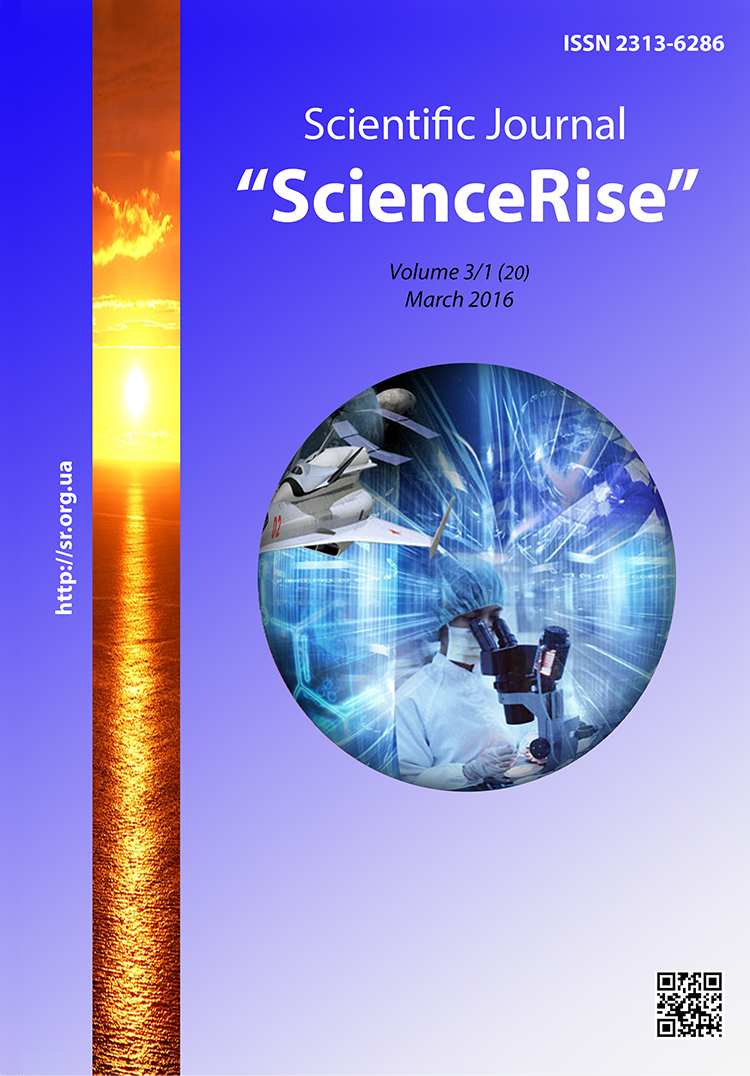Gene regulation of telomere length in human peripheral blood lymphocytes in early and remote perods after irradiation
DOI:
https://doi.org/10.15587/2313-8416.2016.63344Keywords:
gene expression, TERF1, TERF2, TERT, telomere, ionizing radiation, Chernobyl, "Shelter" objectAbstract
Radiation-associated violations of gene regulation of lymphocytes telomere length in early and late period after exposure are investigated. In Chernobyl clean-up workers in the range of doses more than 500 mSv was set reduction of relative telomere length and imbalance in TERF1, TERF2 gene expression on the background of p53-mediated activation of telomerase activity. The early period after professional exposure in“Shelter” object characterized by impairment of protective function of telomeres
References
Blackburn, E. H. (2001). Switching and Signaling at the Telomere. Cell, 106 (6), 661–673. doi: 10.1016/s0092-8674(01)00492-5
Chai, W., Shay, J. W., Wright, W. E. (2005). Human Telomeres Maintain Their Overhang Length at Senescence. Molecular and Cellular Biology, 25 (6), 2158–2168. doi: 10.1128/mcb.25.6.2158-2168.2005
Franco, S. (2005). Effectors of mammalian telomere dysfunction: a comparative transcriptome analysis using mouse models. Carcinogenesis, 26 (9), 1613–1626. doi: 10.1093/carcin/bgi107
Kurz, D. J. (2004). Telomere biology in cardiovascular disease. Cardiovaskular Medicin, 7, 433–442.
LeBel, C. (2005). Telomeres: what’s new at your end? Journal of Cell Science, 118 (13), 2785–2788. doi: 10.1242/jcs.02394
Herbig, U., Sedivy, J. M. (2006). Regulation of growth arrest in senescence: Telomere damage is not the end of the story. Mechanisms of Ageing and Development, 127 (1), 16–24. doi: 10.1016/j.mad.2005.09.002
Blasco, M. A. (2005). Telomeres and human disease: ageing, cancer and beyond. Nature Reviews Genetics, 6 (8), 611–622. doi: 10.1038/nrg1656
Zhou, X. Z., Lu, K. P. (2001). The Pin2/TRF1-Interacting Protein PinX1 Is a Potent Telomerase Inhibitor. Cell, 107 (3), 347–359. doi: 10.1016/s0092-8674(01)00538-4
Moskalev, A. A. (2008). Stareniye i geni [Aging and genes]. Sankt-Peterburg: Nauka, 358.
Collado, M., Blasco, M. A., Serrano, M. (2007). Cellular Senescence in Cancer and Aging. Cell, 130 (2), 223–233. doi: 10.1016/j.cell.2007.07.003
Engelhardt, M., Mackenzie, K., Drullinsky, P. (2000). Telomerase activity and telomere length in acute and chronic leukaemia, pre and post-ex vivo culture. Cancer Res., 1 (60), 610–617.
Deng, Y., Chang, S. (2007). Role of telomeres and telomerase in genomic instability, senescence and cancer. Laboratory Investigation, 87 (11), 1071–1076. doi: 10.1038/labinvest.3700673
Melnikov-Hablo, Е. Е., Telegeev, G. D., Guseva, S. A. (2006). Telomeri i telomerasnaya aktivnost pri zlokachestvennih opuholyah krovi [Teromeres and telomerase activity in malignant tumors of blood]. Ukrainian Journal of Hematology and Blood Transfusion, 3, 5–10.
Egorov, E. E. (2010). Telomeri, telomerase, kancerogenes i mera zdorovya [Telomeres, telomerase, cancerogenesis and health measure]. Cinical oncohematology, 3 (2), 184–197.
Joo, O. H., Hande, M. P., Lansdorp, P. M., Natarajan, A. T. (1998). Induction of telomerase аctivity and chromosome aberrations in human tumour cell lines following X-irradiation. Mutation Research/Fundamental and Molecular Mechanisms of Mutagenesis, 401 (1-2), 121–131. doi: 10.1016/s0027-5107(97)00321-7
Hande, M. P., Lansdorp, P. M., Natarajan, A. T. (1998). Induction of telomerase activity by in vivo X-irradiation of mouse splenocytes and its possible role in chromosome healing. Mutation Research/Fundamental and Molecular Mechanisms of Mutagenesis, 404 (1-2), 205–214. doi: 10.1016/s0027-5107(98)00115-8
Report to the General Assembly, with scientific annexes Volume II: Scientific Annexes C, D and E Annex C: Non-targeted and delayed effects of exposure to ionizing radiation (2006). United Nations Scientific Committee on the Effects of Atomic Radiation (UNSCEAR), 80. Available at: http://www.unscear.org
Zvereva, M. E., Scherbakova, D. M., Doncova, O. A. (2010). Telomerasa: struktura, funkcii i puti regulacii aktivnosti [Telomerase: structure, functions and pathways of regulation activity]. Success of Biological Chemistry, 50, 155–202.
Downloads
Published
Issue
Section
License
Copyright (c) 2016 Ірина Миколаївна Ільєнко, Димитрій Анатолійович Базика

This work is licensed under a Creative Commons Attribution 4.0 International License.
Our journal abides by the Creative Commons CC BY copyright rights and permissions for open access journals.
Authors, who are published in this journal, agree to the following conditions:
1. The authors reserve the right to authorship of the work and pass the first publication right of this work to the journal under the terms of a Creative Commons CC BY, which allows others to freely distribute the published research with the obligatory reference to the authors of the original work and the first publication of the work in this journal.
2. The authors have the right to conclude separate supplement agreements that relate to non-exclusive work distribution in the form in which it has been published by the journal (for example, to upload the work to the online storage of the journal or publish it as part of a monograph), provided that the reference to the first publication of the work in this journal is included.

